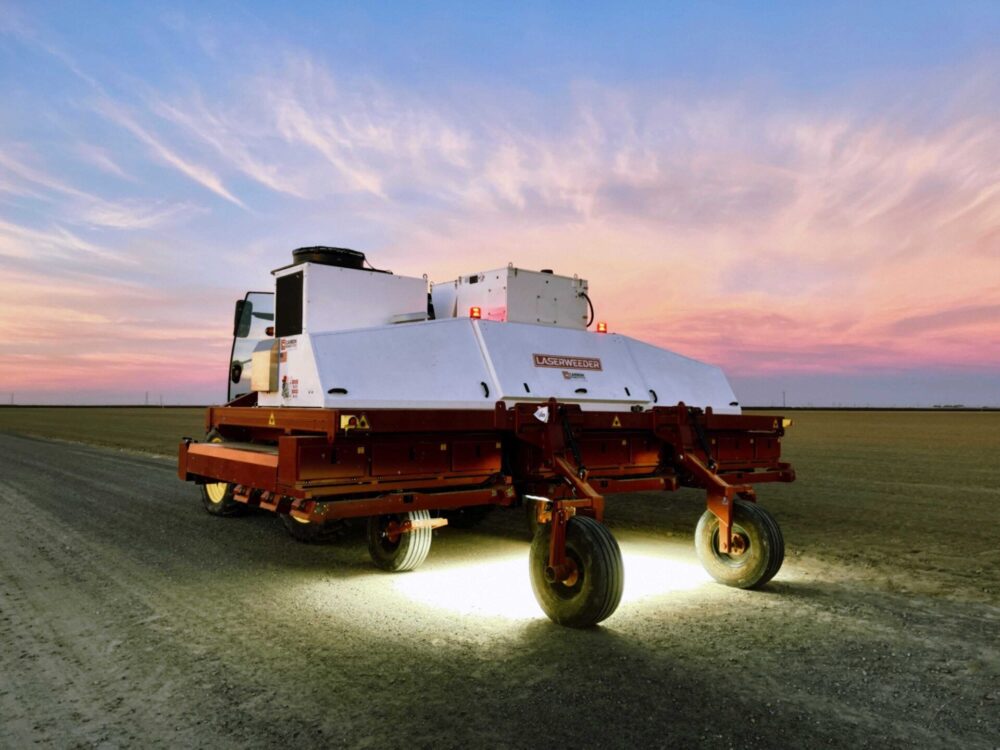- Carbon Robotics has raised a $30 million Series C for its precision weed-control system for speciality crops.
- New investor Sozo Ventures led the round with participation from existing investors Anthos Capital, Fuse Venture Capital, Ignition Partners, Liquid2 and Voyager Capital.
- Funding will go towards expanding US-based Carbon Robotics’ system in North America, new software and hardware products and launching into international markets.
- The Series C brings Carbon Robotics’ total funding to $67 million.

500 million weeds and counting
The LaserWeeder, an autonomous robot, uses AI and CO2 laser technology to target and eliminate weeds in the field with what the company claims is “millimeter accuracy, without damaging nearby crops or disturbing the soil.”
Carbon Robotics CEO Paul Mikesell says the decision to tackle weeds came about after conversations with farmers. The biggest challenge wasn’t the weeds themselves, but finding enough labor to manage them.
“Most of our agricultural work in the United States comes from guest workers and the H-2A visa program [for temporary workers]. It’s hard to get enough people to fulfill those roles, and for things like pulling weeds, which is probably the lowest-value work an intelligent human could do, it doesn’t make a lot of sense to deploy people into the field.”
But many growers Mikesell and his team spoke with didn’t have another choice.
“Combine that with the herbicide resistance showing up in the weed population — these weeds are becoming resistant to glyphosate — and farmers are getting kind of desperate around this issue.”
Computer vision on the machine identifies the weeds, helping the ‘bot to distinguish between them and actual crops. This lessens the need for herbicides in traditional farming and reduces or eliminates over-tilling for farmers using regenerative practices.
Seattle, Washington-based Carbon Robotics says so far it has “successfully eliminated” more than 500 million weeds across 40 different crops. In 2023, the company will deliver LaserWeeder across 17 US states and three provinces in Canada.
Carbon Robotics’ first machines shipped 11 months ago. Mikesell says the company is now getting consistent repeat orders from farmers who are “very happy.”
The company will use its new funding to scale manufacturing and move into new regions in the United States.
A move to Europe is in the works for next year, as are plans to expand the engineering team and develop new products and enhancements.

A focus on ‘quality per plant’
The company works mainly in specialty crops, although Mikesell says it has done “some work in commodity crops.”
Mikesell says specialty crops are especially important for Carbon Robotics customers because existing herbicide options aren’t always adequate.
“People care about the quality, nutrient content and texture of the plant because they’re eating it directly. [Farmers] want to increase their yield per unit acre. The best way to do that is with very precise or targeted weed control that allows you to get rid of the weeds without disturbing the plants, and also allows you to plant more densely.”
“You can get more produce per unit acre because [LaserWeeder] allows you to get in between plants,” he adds. “That’s a big contrast to the commodity crops, where they’re not so concerned with that stuff because most of the wheat and soy gets processed and turned into other things. There’s a lot less focus on the overall quality per plant.”
‘We started in the fields from day one’
On raising $30 million in a downturn, Mikesell simply jokes, “This is one of those environments where the signal really rises above the noise. If you have the goods, people flock to [them].”
On a more serious note, he attributes his company’s success so far to the team’s commitment to continually be out in the field, rather than in a lab.
“One of the most important things for a company trying to develop real-world machinery is to get out into the field and understand the operating environment and do early testing constantly,” he says. “As AI folks decide they want to build robots, we’re going to see people who are many times trying to build in a lab and not realizing what’s in the actual operating environment.
“We started in the fields from day one and have consistently been in the fields,” he adds. “That means understanding moisture, heat and humidity, what the ground conditions are like and the variation in soil types across regions. What the different weeds are and how much energy it takes to kill a weed.”
Understanding how machines fit into different local farming practices is also critical, he says. Farmers using those machines should be viewed more as partners than customers.
“If you want to build a good product, the best thing to do is partner with your early adopters instead of just treating them like customers and trying to sell them stuff,” he says.



